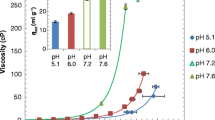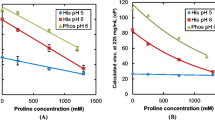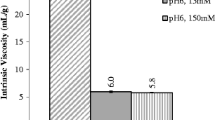ABSTRACT
Purpose
The large increase in viscosity of highly concentrated monoclonal antibody solutions can be challenging for downstream processing, drug formulation, and delivery steps. The objective of this work was to examine the viscosity of highly concentrated solutions of a high purity IgG1 monoclonal antibody over a wide range of protein concentrations, solution pH, ionic strength, and in the presence / absence of different excipients.
Methods
Experiments were performed with an IgG1 monoclonal antibody provided by Amgen. The steady-state viscosity was evaluated using a Rheometrics strain-controlled rotational rheometer with a concentric cylinder geometry.
Results
The viscosity data were well-described by the Mooney equation. The data were analyzed in terms of the antibody virial coefficients obtained from osmotic pressure data evaluated under the same conditions. The viscosity coefficient in the absence of excipients was well correlated with the third osmotic virial coefficient, which has a negative value (corresponding to short range attractive interactions) at the pH and ionic strength examined in this work.
Conclusions
These results provide important insights into the effects of intermolecular protein-protein interactions on the behavior of highly concentrated antibody solutions.






Similar content being viewed by others
Abbreviations
- BSA:
-
Bovine serum albumin
- IgG:
-
Immunoglobulin G
References
Shire SJ, Shahrokh Z, Liu J. Challenges in the development of high protein concentration formulations. J Pharm Sci. 2004;93(6):1390–402.
Liu J, Nguyen MD, Andya JD, Shire SJ. Reversible self-association increases the viscosity of a concentrated monoclonal antibody in aqueous solution. J Pharm Sci. 2005;94(9):1928–40.
Chari R, Jerath K, Badkar A, Kalonia D. Long- and short-range electrostatic interactions affect the rheology of highly concentrated antibody solutions. Pharm Res. 2009;26(12):2607–18.
Saito S, Hasegawa J, Kobayashi N, Kishi N, Uchiyama S, Fukui K. Behavior of monoclonal antibodies: relation between the second virial coefficient (B2) at low concentrations and aggregation propensity and viscosity at high concentrations. Pharm Res. 2012;29(2):397–410.
Russel WB. The dynamics of colloidal systems. Madison: The University of Wisconsin Press; 1987.
Sarangapani PS, Hudson SD, Migler KB, Pathak JA. The limitations of an exclusively colloidal view of protein solution hydrodynamics and rheology. Biophys J. 2013;105(10):2418–26.
Yadav S, Laue TM, Kalonia DS, Singh SN, Shire SJ. The influence of charge distribution on self-association and viscosity behavior of monoclonal antibody solutions. Mol Pharm. 2012;9(4):791–802.
Binabaji E, Rao S, Zydney AL. The osmotic pressure of highly concentrated monoclonal antibody solutions: effect of solution conditions. Biotech Bioeng. 2014;111(3):529–36.
Castellanos MM, Pathak JA, Colby RH. Both protein adsorption and aggregation contribute to shear yielding and viscosity increase in protein solutions. Soft Matter. 2014;10(1):122–31.
Connolly BD, Petry C, Yadav S, Demeule B, Ciaccio N, Moore JM, et al. Weak interactions govern the viscosity of concentrated antibody solutions: high-throughput analysis using the diffusion interaction parameter. Biophys J. 2012;103(1):69–78.
Mooney M. The viscosity of a concentrated suspension of spherical particles. J Colloid Sci. 1951;6(2):162–70.
Ross PD, Minton AP. Hard quasispherical model for the viscosity of hemoglobin solutions. Biochem Biophys Res Commun. 1977;76(4):971–6.
Bowen MN, Liu J, Patel AR. Compositions and methods useful for reducing the viscosity of protein-containing formulations. 2011;EP 2566510 A1.
Arakawa T, Ejima D, Tsumoto K, Obeyama N, Tanaka Y, Kita Y, et al. Suppression of protein interactions by arginine: a proposed mechanism of the arginine effects. Biophys Chem. 2007;127(1–2):1–8.
Siddique J, Naqvi S. Viscosity behavior of α-amino acids in acetate salt solutions at temperatures (303.15 to 323.15) K. Int J Thermophys. 2012;33(1):47–57.
Heinen M, Zanini F, Roosen-Runge F, Fedunova D, Zhang F, Hennig M, et al. Viscosity and diffusion: crowding and salt effects in protein solutions. Soft Matter. 2012;8(5):1404–19.
Vilker VL, Colton CK, Smith KA. The osmotic pressure of concentrated protein solutions: effect of concentration and pH in saline solutions of bovine serum albumin. J Colloid Interf Sci. 1981;79(2):548–66.
ACKNOWLEDGMENTS AND DISCLOSURES
The authors would like to acknowledge Amgen, Inc. for donation of the monoclonal antibody and for their financial support. The authors would also like to thank Dr. Ralph Colby in the Department of Materials Science and Engineering at Penn State for use of the RFS II Rheometrics Fluids Spectrometer.
Author information
Authors and Affiliations
Corresponding author
Rights and permissions
About this article
Cite this article
Binabaji, E., Ma, J. & Zydney, A.L. Intermolecular Interactions and the Viscosity of Highly Concentrated Monoclonal Antibody Solutions. Pharm Res 32, 3102–3109 (2015). https://doi.org/10.1007/s11095-015-1690-6
Received:
Accepted:
Published:
Issue Date:
DOI: https://doi.org/10.1007/s11095-015-1690-6




